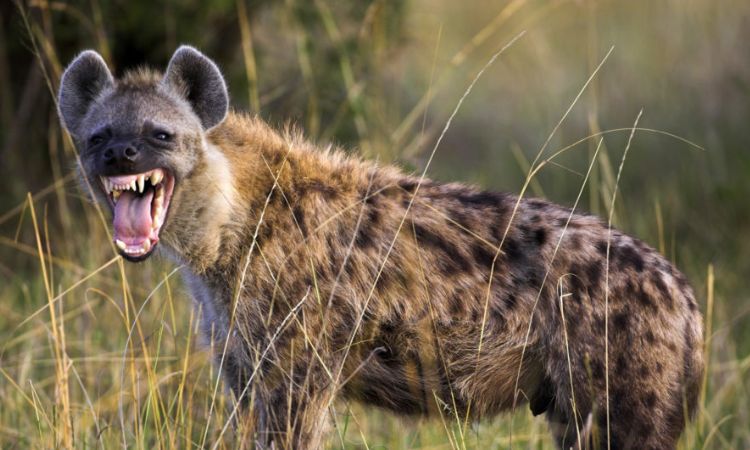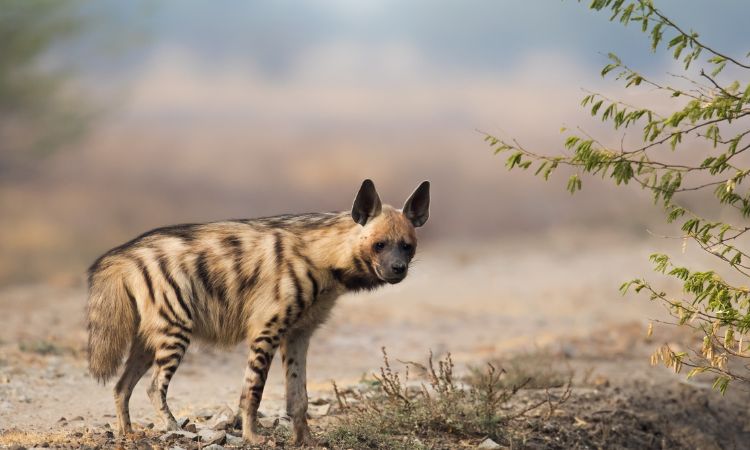The Hyena: A Misunderstood Master of Survival
Hyena: uncover all that you need to know about a hyena from the different hyena species, such as the spotted hyena, to their sounds, bite force, habitats, and more in thiss comprehensive guide.
The hyena, a carnivore of the family Hyaenidae, is a creature of remarkable adaptability, intelligence, and ecological importance.
Often unfairly cast as a cowardly scavenger, this fascinating creature is intelligent, social, and highly adaptable mammal with unique behaviors and characteristics.
In this guide, we’ll explore hyena facts, their behavior, habitat, diet, species, and their role in the ecosystem.
What is a Hyena? An Overview
Hyenas, scientifically classified under the family Hyaenidae, are carnivorous mammals native to Africa and parts of Asia. Despite their dog-like appearance, hyenas are more closely related to cats and mongooses than canines.
Known for their distinctive vocalizations, often described as a “laugh” or “giggle,” hyenas are highly social animals that thrive in complex group structures. Below are some quick hyena animal facts:
- Scientific Family: Hyaenidae
- Lifespan: 12–25 years, depending on the species
- Diet: Carnivorous, opportunistic feeders
- Habitat: Savannas, grasslands, woodlands, and semi-deserts
- Conservation Status: Varies by species (e.g., spotted hyena: Least Concern; brown hyena: Near Threatened)
What do hyenas look like?” They have powerful jaws, robust builds, and distinctive features like a sloping back and large heads. Their unique biology and behavior make them one of nature’s most intriguing predators.

Hyena Species
The Hyaenidae family comprises four extant species, each adapted to distinct ecological niches:
- Spotted Hyena (Crocuta crocuta): The largest and most widespread, found across sub-Saharan Africa in savannas, grasslands, and woodlands. Known for their complex social structures and hunting prowess, they are the most studied hyena species.
- Striped Hyena (Hyaena hyaena): Smaller and more solitary, inhabiting arid regions from North Africa to the Middle East and India. They primarily scavenge but occasionally hunt small prey.
- Brown Hyena (Parahyaena brunnea): Found in southern Africa, particularly in deserts and semi-arid areas, this shy species relies heavily on scavenging and lives in small, loosely organized groups.
- Aardwolf (Proteles cristata): The smallest hyena, native to East and Southern Africa, it is an insectivore specializing in termites, with a diet and behavior distinct from its carnivorous relatives.
These species showcase the diversity of the Hyaenidae family, with adaptations ranging from bone-crushing predation to termite foraging.
Taxonomy: Closer to Cats or Dogs?
Despite their dog-like appearance, hyenas are not closely related to canids. They belong to the suborder Feliformia, making them more closely related to cats, mongooses, and civets than to dogs, which fall under Caniformia.
This taxonomic distinction is rooted in their evolutionary divergence around 30 million years ago. Anatomically, hyenas share traits with felids, such as retractable claws in some species and a skeletal structure more akin to cats.
However, their social behaviors and scavenging habits superficially resemble those of canids, contributing to the confusion. Molecular studies confirm their closer kinship to cats, placing them firmly in the feliform lineage.
Physical Characteristics and Bite Force
Hyenas are built for endurance and power. The spotted hyena, weighing 40-86 kg (88-190 lbs), exhibits sexual dimorphism, with females larger than males—a rarity among mammals.
Their robust skulls house some of the most powerful jaws in the animal kingdom. The spotted hyena’s bite force is estimated at up to 1,000 pounds per square inch, allowing them to crush bones and consume virtually every part of a carcass.
This extraordinary bite strength, driven by large premolars and strong jaw muscles, surpasses that of most large carnivores, including lions (around 650 psi) and wolves (around 400 psi).
Striped and brown hyenas have slightly less powerful bites but are still capable of cracking bones, while the aardwolf’s smaller jaws are adapted for consuming termites.
The spotted hyena’s sloping back, due to longer forelimbs, aids in long-distance pursuits, and their coarse, spotted coat provides camouflage.
The female spotted hyena’s pseudo-penis, an elongated clitoris, is a unique feature used for social signaling and reproduction, complicating mating and birth.
Hyena Behavior: Social Structures and Communication
Hyenas are renowned for their complex social behaviors, particularly among spotted hyenas.Below are hyena behaviours:
- Matriarchal Societies: Spotted live in clans led by a dominant female, known as the matriarch. These clans can include up to 80 individuals, with females holding higher ranks than males. This structure is a key point for searches like “hyena social structure” or “hyena matriarchy.”
- Vocalizations: The iconic “hyena laugh” is a form of communication used to signal excitement, submission, or territorial presence. Spotted hyenas also use whoops, growls, and groans to coordinate within clans. This answers queries like “why do hyenas laugh” or “hyena sounds meaning.”
- Hunting and Scavenging: Contrary to the scavenger stereotype, spotted hyenas are adept hunters, often working in groups to take down large prey. Striped and brown hyenas, however, rely more on scavenging. This dual role is a popular topic for “hyena diet” or “do hyenas hunt.”
- Intelligence: Hyenas exhibit problem-solving skills and social intelligence comparable to primates. Studies show they can recognize clan members and adapt strategies during hunts, making them a subject of interest for “hyena intelligence” searches.
Hyena Habitat and Distribution
Where do Hyenas live? They inhabit a range of environments, from the savannas of East Africa to the deserts of the Middle East.
- Spotted Hyenas: Found across Sub-Saharan Africa, thriving in grasslands, savannas, and woodlands. They adapt well to human-altered landscapes.
- Striped Hyenas: Range from North Africa to India, preferring arid regions and scrublands.
- Brown Hyenas: Restricted to Southern Africa, often in desert and coastal areas.
- Aardwolves: Inhabit grassy plains and savannas where termite mounds are abundant.
Spotted hyenas roam Uganda’s savannas in Queen Elizabeth, Kidepo Valley, Murchison Falls, Lake Mburo, and Pian Upe parks. striped hyenas lurk rarely in Kidepo. Witness their laughs by booking our Uganda safari packages now for unforgettable thrills!

Hyena Diet: What Do Hyenas Eat?
These are opportunistic feeders with diets varying by species. There diet is as follows:
- Spotted Hyenas: Primarily carnivorous, they hunt antelopes, zebras, and even young giraffes. They also scavenge carrion and can consume bones due to their powerful jaws.
- Striped and Brown Hyenas: Rely heavily on carrion, small mammals, birds, and occasionally fruits or human food waste.
- Aardwolf: Almost exclusively eats termites, consuming up to 300,000 in a single night.
Hyenas’ digestive systems are uniquely adapted to process tough materials like bones and hooves, making them efficient “clean-up crews” in their ecosystems.
Hyena Reproduction and Life Cycle
Spotted hyenas reproduce in a unique matriarchal system, with females dominant and larger than males. Females have a pseudo-penis, complicating mating and birth.
After a 110-day gestation, one to three cubs are born in dens, facing intense sibling rivalry, often resulting in siblicide. Hyena Cubs nurse for up to 18 months and reach sexual maturity at 2-3 years.
Striped and brown hyenas have simpler reproductive systems, while aardwolves produce small litters, with cubs maturing faster.
Hyena Sounds
Hyenas are highly vocal, with the spotted hyena’s “laugh” or whoop being the most iconic. This eerie, high-pitched call, which can carry over 5 kilometers, signals excitement, group cohesion, or distress during hunts or conflicts.
Contrary to its association with cowardice, the laugh is a complex communication tool, varying in pitch to convey individual identity, rank, or intent.
Other vocalizations include growls, grunts, giggles, and low-frequency “groans” used in close-range interactions. Striped and brown hyenas produce similar but less varied sounds, while the aardwolf’s softer vocalizations, like barks and whines, suit its less social lifestyle. These sounds are critical for maintaining social bonds and coordinating group activities.
Social Structure and Behavior
Spotted hyenas live in clans of up to 80 individuals, led by a dominant female matriarch in a strict matriarchal hierarchy. Females inherit rank from their mothers, securing access to resources and mating opportunities.
Males, lower in status, often disperse to other clans, navigating complex social dynamics to reproduce. The pseudo-penis plays a role in dominance displays, reinforcing female authority.
Hyena Cubs, born in litters of one to three, face intense sibling rivalry, sometimes resulting in siblicide to eliminate competition.
Spotted hyenas are skilled hunters, taking down prey like wildebeest or zebra in coordinated group efforts, though they scavenge opportunistically. Studies indicate 70% of their diet comes from their own kills.
Striped and brown hyenas are more solitary, relying on scavenging, while the aardwolf consumes up to 300,000 termites nightly, using its sticky tongue. Hyena intelligence, comparable to primates, is evident in their problem-solving and social strategies.
Hyena vs Lion
Hyenas and lions are fierce competitors in the African savanna, often clashing over kills. Spotted hyenas, with their pack mentality, can challenge lions effectively.
A single hyena is no match for a lion, but a clan of hyenas can overpower a lone lion or small pride, using numbers and coordination to steal kills or defend their own.
Lions, in turn, may kill hyenas to eliminate competition, but fatalities are less common than popular media suggests. These interactions are dynamic: a large hyena clan can drive off a single lion, while a pride of lions typically dominates smaller hyena groups. This rivalry underscores the hyena’s strength and tenacity, challenging the notion of them as mere scavengers.

Are Hyenas Dangerous?
Hyenas, particularly spotted hyenas, are formidable predators but are not inherently aggressive toward humans. Their danger lies in their strength, bite force, and group dynamics.
In areas where humans encroach on their habitat or compete for resources, hyenas may attack livestock, leading to retaliatory killings.
While rare, attacks on humans have occurred, typically in regions with food scarcity or when hyenas are provoked. For example, in rural Ethiopia, striped hyenas have been known to scavenge near human settlements, occasionally attacking if cornered or starving. Spotted hyenas, bolder in groups, may pose a risk in extreme circumstances, but such incidents are uncommon.
Are Hyenas a Danger to Humans?
To address this specifically, hyenas are generally not a significant threat to humans. Most species avoid human contact, and attacks are rare, often linked to specific conditions like habitat encroachment, food shortages, or provocation.
Spotted, due to their size and social nature, are the most likely to interact with humans, but documented attacks are few.
triped and brown hyenas are shyer, and the aardwolf poses no threat due to its insectivorous diet. Education and coexistence strategies, like securing livestock, can minimize risks.
Ecological Role
Hyenas are keystone species, regulating herbivore populations and recycling nutrients by consuming carrion and bones. Spotted hyenas control prey populations, while striped and brown hyenas clean up carcasses, reducing disease spread.
The aardwolf manages termite populations, supporting vegetation. Their interactions with lions and other predators shape savanna ecosystems, influencing prey and competitor behavior.
Hyenas in Culture and Misconceptions
Hyenas often suffer from a negative reputation, portrayed as cowardly or sinister in folklore and media. However, these misconceptions don’t align with reality. For searches like “hyena myths” or “hyenas in culture”:
- Cultural Significance: In some African cultures, hyenas are associated with witchcraft or trickery, while others respect their strength and cunning.
- Media Portrayal: Films like The Lion King perpetuate the scavenger stereotype, overshadowing their hunting prowess and intelligence.
- Conservation Efforts: Raising awareness about hyenas’ ecological role is crucial, especially for endangered species like the brown hyena.

Adaptability and Conservation
Hyenas thrive in diverse habitats, from savannas to deserts, due to their opportunistic diets and intelligence. However, habitat loss, human-wildlife conflict, and poisoning threaten their populations.
Conservation efforts, including education and livestock compensation programs, aim to protect them. Long-term studies, like those in the Serengeti, highlight their ecological importance, challenging myths and fostering appreciation.
Fun Hyena Facts for Kids and Enthusiasts
- Hyenas can run up to 37 mph (60 km/h).
- Their bite force is among the strongest of any mammal.
- Aardwolves use their sticky tongues to lap up termites, like anteaters.
